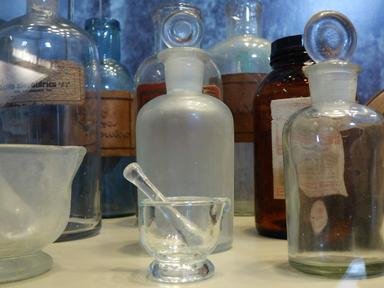Quiz Answer Key and Fun Facts
1. As you are sitting in your office on a particularly fine morning, you hear a knock at the door. "Come in," you respond vacantly and the door opens to reveal a family of four. A young, blonde woman, wearing a short red skirt, red high-heeled shoes and a red blazer over a white blouse is the first to enter. She is followed by a man with dark hair who is wearing a black suit and tie. The children follow timidly, the girl wearing a light blue dress and the boy a pair of grey trousers and a white shirt.
"Hello Arthur, what brings you back to the Mendeleyev School?" you inquire politely, a little confused about why a man who left your school 10 years ago without a single qualification has come back, along with his entire family.
"Well," Arthur begins, "I have a small problem. My grandfather had managed to acquire a wonderful set of platinum jewellery, which he has left to me."
"I see," you say, now completely confused. Being an under-paid chemistry teacher you cannot see any problem in receiving platinum jewellery and cannot believe that this man sees a problem, nor understand what this has to do with you.
"Well, I cannot see the problem with that," you finish.
"Well," Arthur resumes, "my grandfather was a chemist and never forgave me for failing my chemistry exams. Therefore, he locked his jewellery in a safe and in order to open it, you have to enter ten passwords. The passwords are all the answers to questions about elements, which I simply cannot answer. Furthermore, if you enter an incorrect answer, the safe will be sealed forever. So, I was wondering if you might be able to help me."
Having agreed to help and arrived at the house of the Peterson family, you are now looking at the first question.
"Question One: Which of the following famous scientists does not have an element named after him?"
2. Carefully, you type the correct answer into the safe. After a short pause, the word "CORRECT" appears on the LED display. You breathe a sigh of relief and the Peterson family all cheer.
"Well done, professor," says Arthur, smiling broadly. "What is question two?" In response to this you look at the piece of paper and read:
"Question Two: Which of the following elements is not a noble gas?"
3. There is another cheer as the word "CORRECT" appears. Relieved, you proceed to question three.
"Question Three: How many protons are in the nucleus of mercury?"
4. As the word "CORRECT" moves across the screen and the Peterson family cheer, you feel as if you could join in with them. However, there are still seven more questions to answer, so you move onto the next question.
"Question Four: Which of the following elements is a lanthanide?"
5. As the word "CORRECT" is once again shown on the screen, you begin to feel a little excited about the prospect of opening the safe and seeing the look on the faces of the Peterson family, which is currently dancing around the room. With this in mind, you proceed to the next question.
"Question Five: Which of the following elements is not used in radiotherapy?"
6. The Peterson family cheer louder than ever as the word "CORRECT" moves across the screen and everybody in the room begins to think that opening the safe might just be possible. With the thought of opening the safe encouraging you, you move onto question six.
"Question Six: Which of the following elements is not synthetically produced?"
7. This time, when the word "CORRECT" appears on the screen, you allow yourself a few moments to join in with the cheering of the Peterson family, before you move on quickly to question seven, the thought of having four questions left driving you on and limiting your relief.
"Question Seven: Which of the following is the sodium ion?"
8. Again, as the word "CORRECT" moves across the screen, you cannot help but give a small cheer. However, you limit yourself to this, as there are still three more questions left. With this in mind, you move on to question eight.
"Question Eight: What is the definition of an anion?"
9. With only two more questions left, the anticipation and excitement is beginning to subside to be replaced by extreme tension. Therefore, you move quickly on to question nine.
"Question Nine: What is the electron shell configuration of Argon?"
10. As the words "CORRECT" are shown, everybody anticipates the final question. There was always tension, but there was the relief and happiness of having correctly answered a question. Now, however, there was nothing but tension. You move on to question ten, your heart pounding inside your chest.
"Question Ten: From where is the name platinum derived from?"
Source: Author
DanielPoulson
This quiz was reviewed by FunTrivia editor
crisw before going online.
Any errors found in FunTrivia content are routinely corrected through our feedback system.
